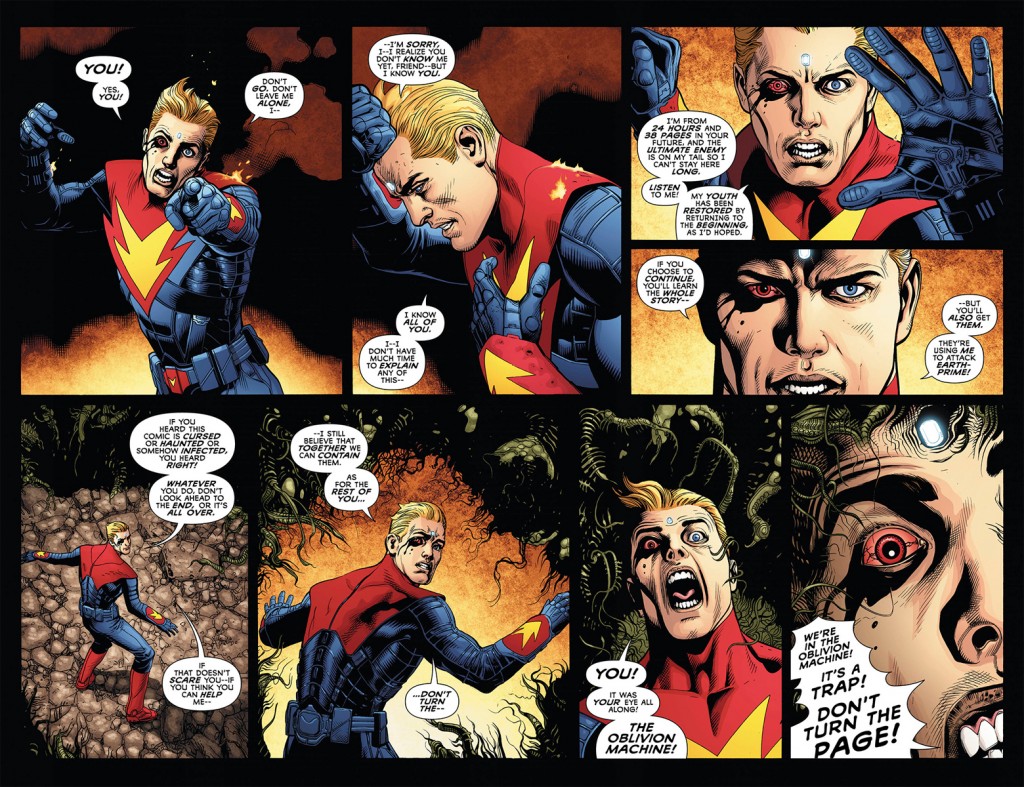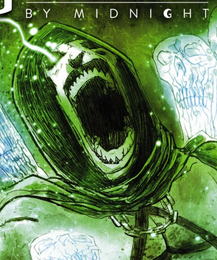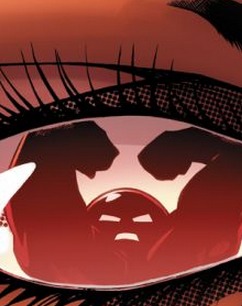Deadshirt Is Reading… is a weekly feature in which Deadshirt’s staff, contributing writers, and friends-of-the-site offer their thoughts on Big Two cape titles, creator-owned books, webcomics and more. For more of our thoughts on this week’s new comics, take a look at Wednesday’s Deadshirt Comics Shopping List.
Dom, David, Jason, Joe and Max are reading…
In this month’s Multiversity Roundtable, Deadshirters Max Robinson, Dominic Griffin, Jason Urbanciz, David Uzumeri, and Joe Stando fine-tuned their vibrational frequencies and shared their impressions of the installment out this week.
The Multiversity: Ultra Comics #1
Written by Grant Morrison
Art by Doug Mahnke (pencils) and Christian Alamy, Mark Irwin, Keith Champagne and Jamie Mendoza (inks)
Colored by Gabe Eltaeb and David Baron
Lettered by Steve Wands
DC Comics
“Ultra Comics. Made to confront a threat no single ordinary being could deal with! Designed as the ultimate warrior in a battle for your very souls!”
Ultra Comics, this month’s penultimate installment of The Multiversity, has been alluded to (threatened?) since the very first issue. Appearing as an ominous background artifact, Ultra Comics seemingly plays a role in the infection of “evil” in each story’s universe. The final product is arguably the most ambitious and experimental issue so far, Morrison and artist Doug Mahnke’s attempt at a “living” comic book. Ultra Comics lacks the emotional resonance of the best installments of Multiversity, but it makes up for it in terms of the cleverness of its conceit: Ultra Comics, the book and its star, a lab-engineered superhero *named* Ultra Comics, are one and the same. When we open the issue, Ultra is birthed into life; when we close it, he’s destroyed. The story, such as it is, only really exists to facilitate this gimmick but doesn’t hurt for colorful Morrisonian weirdness (Ultra Comics encounters a group of pre-existing DC characters whose names are also variations on his own. Spoilers: They’re cannibals.). There’s a playfulness to how Ultra Comics examines the reader/comic relationship. It’s the DC superhero equivalent of clapping for Tinkerbell. I fully expect this to be the most divisive issue of the series so far.
– Max Robinson
Ultra Comics! It’s finally here. The MacGuffin of the entire Multiversity series, the cursed comic book. And overall? It’s fine. As a series, I feel like Multiversity peaked right in the middle, with the fantastic run of Pax Americana, Thunderworld, and the Guidebook. Maybe it was the loss of momentum with Mastermen, but I wasn’t quite as floored by this book as I had hoped. The concept is definitely rock-solid: a new character, a metaphysical messiah in the mold of Adam Warlock and Marvelman called Ultra Comics, is created explicitly as a fictional concept, a CMYK crusader to fight the Gentry. The issue is also front-loaded with a ton of cool devices, from non-linear scenes and fourth-wall-breaking to an onslaught of lettering tricks to indicate all kinds of voices and tones (seriously, this has to be Steve Wands’ Eisner submission). For me, though, it sort of loses steam as it goes. The bit with the various other “Ultra(a)s” of DC history is clever and Intellectron’s appearance is a pretty great panel, but there’s a little bit less of the clever conceits in their final battle (the “vulnerable to criticism” bit notwithstanding). Being a fan of the metatextual, I still enjoyed this issue a lot, but the end of it stops short of making the top of the Multiversity list for me. Now, there are a lot of people reading this comic who are smarter than me, and it’s entirely possible Dom’s musings or Uzi’s annotations will make more of it “click” for me, but as of right now it hasn’t possessed or infected my brain the way I’d hoped.
– Joe Stando
Ultra Comics is the first issue of Multiversity that makes me feel thick. I think I get it but I can’t help thinking there’s something I’m missing. After teasing this issue throughout the entire series, Ultra Comics, the haunted comic that is infecting the universes in which it appears with The Gentry, has landed on our planet. The idea is that the comic itself is the hero, and by reading it you are fueling him, becoming him. Unfortunately him/we are led into a trap on an almost deserted Earth where refugees (including all of the previous Ultras of the DC Universe) are building a machine aiding the release the Gentry. As I said, the book seems pretty straightforward but I can’t help the gnawing feeling that I’m missing something. Maybe it’s just the Gentry infection taking hold in my fragile psyche. That said, after a down issue art-wise last month, Doug Mahnke does the best work I’ve ever seen out of him. It feels like he toned down some of the hyper-detail of his usual art to give this book, and especially Ultra Comics himself, some extra softness, and it makes the comic more inviting. Despite not being able to fully crack this issue, I’m still fascinated by The Multiversity and am sad it’s all going to be over in a few weeks.
– Jason Urbanciz
Holy dogshit in a Spam can, I am not looking forward to annotating this thing. I thought Pax actively resisted me, but Jesus, this is gonna be a shitshow.
Ultra Comics is definitely an experiment, and I’m not 100% sure if it works, but it’s the most Grant Morrison Superhero Comics thing ever published. It’s the first issue to really make the core themes of Multiversity clear, and they’re far more real-world-applicable than many critics are suggesting; yes, Ultra Comics is a comic about comics, but it’s also a comic—like the rest of Multiversity—about the dangerousness of ideas and the necessity of mental self-care and skepticism. While I felt like Pax Americana actively resisted examination from the reader, Ultra Comics actively resists examination from itself, because, in a very real way, we are Ultra Comics — the superhero is itself the process of reading this comic. It’s a book only Grant Morrison could write; that’s unquestionable. What it asks, though, is if Grant Morrison can only write this book — and I wonder if that isn’t an example of some self-reflection and questioning on Morrison’s part as well.
What’s undeniable, though, is that Doug Mahnke continues to be one of the preeminent superhero artists of our generation. He’s a powerhouse of unbridled imagination and design, with an uncanny ability to translate Morrison’s heady concepts into arresting visuals and straightforward storytelling. Gabe Eltaeb and David Baron acquit themselves incredibly well on the colors, as well, with the book’s subject material allowing them a number of different avenues to play with the very concept of comic book coloring and the print process through which it makes its way to the final page. I do wonder if I left some of the authenticity of the experience behind by reading this in digital format rather than physical—much of Ultra Comics is about the superhero comic as physical object, its particular qualities borderline fetishized, rather than the simple storytelling techniques that make up the comic strip form.
Anyway, if you’re reading Multiversity, this is a can’t-miss issue (although, to be frank, they all are, except maybe Mastermen). It’s the ultimate form of the Grant Morrison meta-comic-about-comics, at least until next month’s #2, and I’m really excited to see how Morrison wraps this all up into a conclusion.
– David Uzumeri
In Supergods, Grant Morrison writes about his personal affection for the cover of The Flash #163, brilliantly realized by the legendary Carmine Infantino. You’ve definitely seen it before. Barry Allen’s sinewy, scarlet suited body racing towards your face, begging you (the reader) to buy the book and read along, as it’s the only thing that will save his life. Morrison wrote about how much this affected him in his youth, the tether created between boy and hero. Even a cursory, surface level read of Morrison’s CV lays his lifelong obsession with this cover bare, but Ultra Comics feels like the culmination of years and years not only trying to break the fourth wall, but to shatter it so completely that no one ever bothers to seal the damn thing back up.
People tend to misread Morrison’s work and presume his preoccupation with metafiction to be a pretentious pastime, the reductive, diminishing returns of a man who has abused too many drugs and fallen asleep reading too many of Gardner Fox’s words. Really, he’s someone whose entire life has been demonstrably improved by the existence of superhero comics, whether through the inspirational teachings of Superman or the heavy checks from a career writing cape comics that helped him buy a fucking castle. They may just be color and pulp, but the real, physical limitations of their dimension are arbitrary. His continued efforts to bring their world and ours closer together, to others, might seem a colossal waste of time at worst and an unfortunate creative crutch at best, but I choose to interpret this nagging theme as the gospel. Not that it’s the end all, be all or sum total of the medium’s worth, but it’s one man forever struggling to bring strangers closer to an understanding, a relationship with a higher power, that has brought him so much joy.
That his final statement on the matter is such a discomfiting downer should tell you something. This entire project has been Grant trying to tell us something, and everyone is STILL too focused on cataloging every fucking Captain Carrot reference to get the message. For The Flash, reading that comic saved his life, but it also saved Grant’s. Reading Ultra Comics didn’t quite save Ultra, and it largely served to give me undesired nightmare fuel, but the connection I’ve felt to The Multiversity as a whole has been nourishing in a way only fiction seems to provide.
Comics need our love and attention as much as we need it to sustain and engross us. As fellow Brit Warren Ellis wrote through Axel Brass in Planetary, the secret of the world is this: “Save it, and it’ll repay you every second of every day.” Grant’s point is, it doesn’t matter if that world is fictive or not.
– Dominic Griffin
Jason Urbanciz is reading…
Written by Ray Fawkes
Art by Ben Templesmith
Lettered by Saida Temofonte
DC Comics
“Is there no good that can grow from tainted ground?”
In the wrap-up of the first arc of Gotham By Midnight, the supernatural entity that has been plaguing Gotham stands revealed, and it is Gotham itself. An amalgamation of all the sin that has piled up in the city, since its beginning when settlers destroyed an entire people just to take their land through today, the entity has been doing everything it can to summon the Spectre from inside police detective Jim Corrigan to rain down God’s judgement upon the sinners of Gotham. And since this is Gotham City, that means everyone. While Batman battles the giant manifestation that rises above the streets of the city, Jim Corrigan’s squad debates whether they should kill Corrigan in order to save the city from the Spectre, with one member of the team making a decision that could save them all.
Gotham by Midnight hasn’t been talked about a lot as part of DC’s recent Bat-office renaissance, but it really should be. While the comic has some roots in what has been happening over in Batman Eternal, the book tells deeply creepy horror stories without much mention of the superhero universe it takes place in (this is Batman’s first appearance in the title). A lot of the atmosphere of this comic is down to Ben Templesmith’s art. His mixture of scratchy pencils and luminescent watercolors are different from what anyone else does, and Ray Fawkes tailors the story perfectly to his work.
Gotham By Midnight asks thoughtful questions about the nature of evil and what is the appropriate response to that evil. Fawkes and Templesmith have created a great core group of characters to delve into the dark secrets of Gotham City. It looks like Templesmith is taking the next story arc off from art duties, but I really hope he returns soon. I’m sure Fawkes can keep it moving without him, but the book will be a little less special until he returns.
Kayleigh Hearn is Reading…
Written by Christopher Yost
Art by Jorge Fornes
Colored by Rachelle Rosenberg
Lettered by VC’s Joe Caramagna
Marvel
“How does one defeat a Living Monolith, anyway?” “Thor usually chucks him into space or something.”
The cyclical nature of superhero comics can be either a blessing or a curse. Think of sweeping status-quo changes like Dick Grayson becoming Batman, or Doctor Octopus becoming Spider-Man: no matter how many fans embrace the dramatic new direction, eventually the clock is reset and the toys are put back in their box. Bruce Wayne will never be out of the cape and cowl for very long. Amazing X-Men #18 isn’t the end of the “Once and Future Juggernaut” arc, but we can hear the reset clock ticking.
The Amazing X-Men, a motley crew featuring Storm, Northstar, Firestar, Pixie, and former Juggernaut Cain Marko, among others, have failed to stop The Living Monolith from gaining the power of Cyttorak and becoming the new Juggernaut. How do you stop an unstoppable opponent? How about sitting down and ignoring it until it goes away? Christopher Yost subverts the reader’s expectations for a sprawling superhero brawl by instead having the X-Men sit by a fire, reminisce, and banter, while the Unstoppable Living Mono-naut stands impotent with no one to fight. I love stories in which the X-Men hang out and try to act like normal people, despite the costumed insanity of their lives—give me any issue of the X-Men playing softball, and I’ll read it—but this comic falls flat. The X-Men come across like bickering co-workers on the world’s worst team-building retreat, and it’s not much fun to read. By the time Iceman was laughing, “Ha ha, Rachel’s dumb!” (ACTUAL DIALOGUE) I was ready to check out of the issue.
What started out as a potentially clever, subversive issue ends with a disappointing cliffhanger. It’s an unsurprising outcome, especially if you expected the story arc’s title to be more than a T. H. White reference. I was hoping for something more exciting, or at least something that would better serve poor, underused Northstar and Firestar. The disappointment is not alleviated by Jorge Fornes’ art, which is serviceable but somewhat clunky and inert. But, the story isn’t over yet. I hope Amazing X-Men has surprises ahead, rather than just stuffing a dinged-up old action figure back in the box.
Thanks for reading about what we’re reading! We’ll be back next week with a slew of suggestions from across the comics spectrum. In the meantime, what are you reading? Tell us in the comments section, on Twitter or on our Facebook Page!






